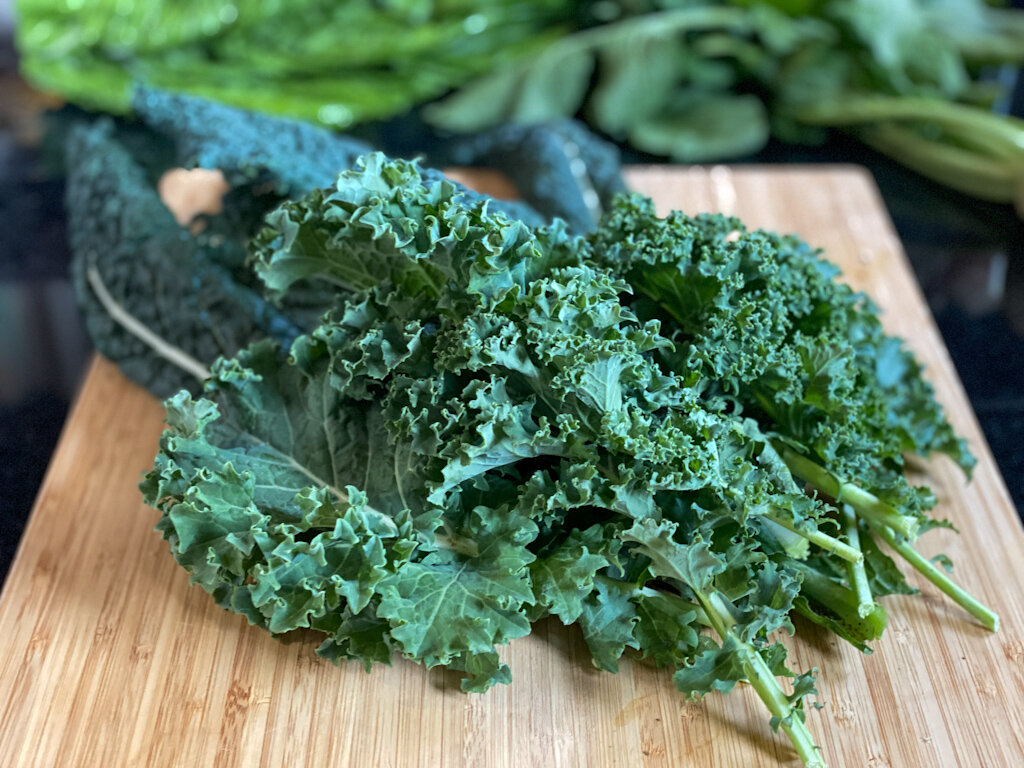Harvest boxes of greens and herbs from La Bajada POP Farm, part of Promise of Peace Gardens, a Dallas-based nonprofit.
Whether it’s from your own garden, the community garden where you’ve been working a plot, the farmers market — or you’ve picked up or ordered a harvest box from a local farm — you suddenly find yourself with armfuls of greens.
I love greens any way I can get them; this time of year and through the winter, I actively crave them. I especially love mustard greens, for their wonderful spiciness, but kale, chard, collards and spinach are wonderful too — and I love to mix them up.
What to do with them?
Sure, you can drop the leaves in a salad. For that, the youngest leaves are best — especially spinach and tangy beet greens. For tougher customers, like kale, a little pre-salad-bowl massage does wonders for mature leaves. Stack them, roll up and slice into chiffonade, then give those ribbons a squeeze before you dress them.
This time of year, soup is front-of-mind. You could make an earthy, vegan, soul-sustaining, feed-you-all-week soup based on lentils, onions, carrot and celery, punctuated by spices and rounded out by all those greens — thrown in at the last minute for maximum flavor and texture.
Here’s a master recipe.
And then there is saag paneer. Did you think the Indian braised greens-and-cheese dish was meant only to include spinach? Actually, in India saag refers to any kinds of greens, as Maneet Chauhan explains in her new cookbook, Chaat. (Read our story about it.) Her version of the classic dish includes kale and arugula along with spinach, but in her headnote she urges inclusion of any greens you’ve got.
Or you could shine a bright spotlight on the greens themselves, making a simple sauté that puts them center stage and celebrates their individual flavors.
During The Great Confinement, Wylie has fashioned himself into the greens specialist of our household. As long as chard (his favorite) is involved, it’s his mission to preside over them and add whatever else looks great. The stems, he feels, are all important. “You’re wasting if you don’t use them,” he says. “That’s not cool. They add texture and emphasize the character of each green. Especially chard.” He slices them into what looks like a small dice, and advocates sautéeing those stems with “some kind of allium,” which for him always includes shallots.
The sautéed stems also give the finished dish a confetti-on-top kind of beauty.
Last week, we purchased a harvest box from a wonderful nonprofit educational farm where we live in Dallas – Promise of Peace Gardens — and we found ourselves in possession of a wealth of gorgeous organic greens: two kinds of kale, rainbow chard and daikon greens.
Kale from our POP Gardens harvest box, with more greens in the background
I convinced Wylie to slow down enough to show me exactly how he achieves his greens greatness.
It starts with sweating shallots in olive oil, then adding garlic, then the toughest sliced stems, then the more tender stems, and then the greens — beginning with the sturdiest (kale and collards, for instance). You add them, and cook till wilted enough to make room for the next batch. Then come the more tender — chard, mustard and/or turnip. And finally the most tender – young arugula, spinach and whatnot. After that, he adds a little chicken broth (vegetable broth or water work fine, too, and keep it vegan), to loosen up the the mix and let it breathe. Finally, off-heat, a dash of vinegar.
They’re super delicious on those evenings when a pot of beans and some brown rice or roasted sweet potatoes feel like healthy luxuries. For omnivores, they’re the perfect minerally counterpoint to something like saucy pork chops, or any kind of roasted or braised meat or poultry. (Duck!)
There you go. If you’ve been hesitating to subscribe to a local farm-box program for fear you’d be awash in stuff you couldn’t use, you have your braising orders.
RECIPE: Maneet Chauhan’s Saag Paneer










